HR Study: Motivation Theories and Marks & Spencer Case Analysis
VerifiedAdded on 2022/12/28
|6
|1347
|67
Report
AI Summary
This report provides a comprehensive overview of human resource management, focusing on employee motivation. It begins by defining human resources and its core functions, including recruitment, selection, training, and performance management. The report then delves into the concept of motivation, exploring both financial and non-financial factors. Several motivational theories are examined, including Maslow's Hierarchy of Needs and Theory X and Theory Y. The practical application of these concepts is illustrated through a case study of Marks and Spencer, analyzing the company's strategies for motivating its employees through training, development, and performance management. The report concludes by summarizing the key takeaways regarding the role of HR and the importance of motivation in the workplace.
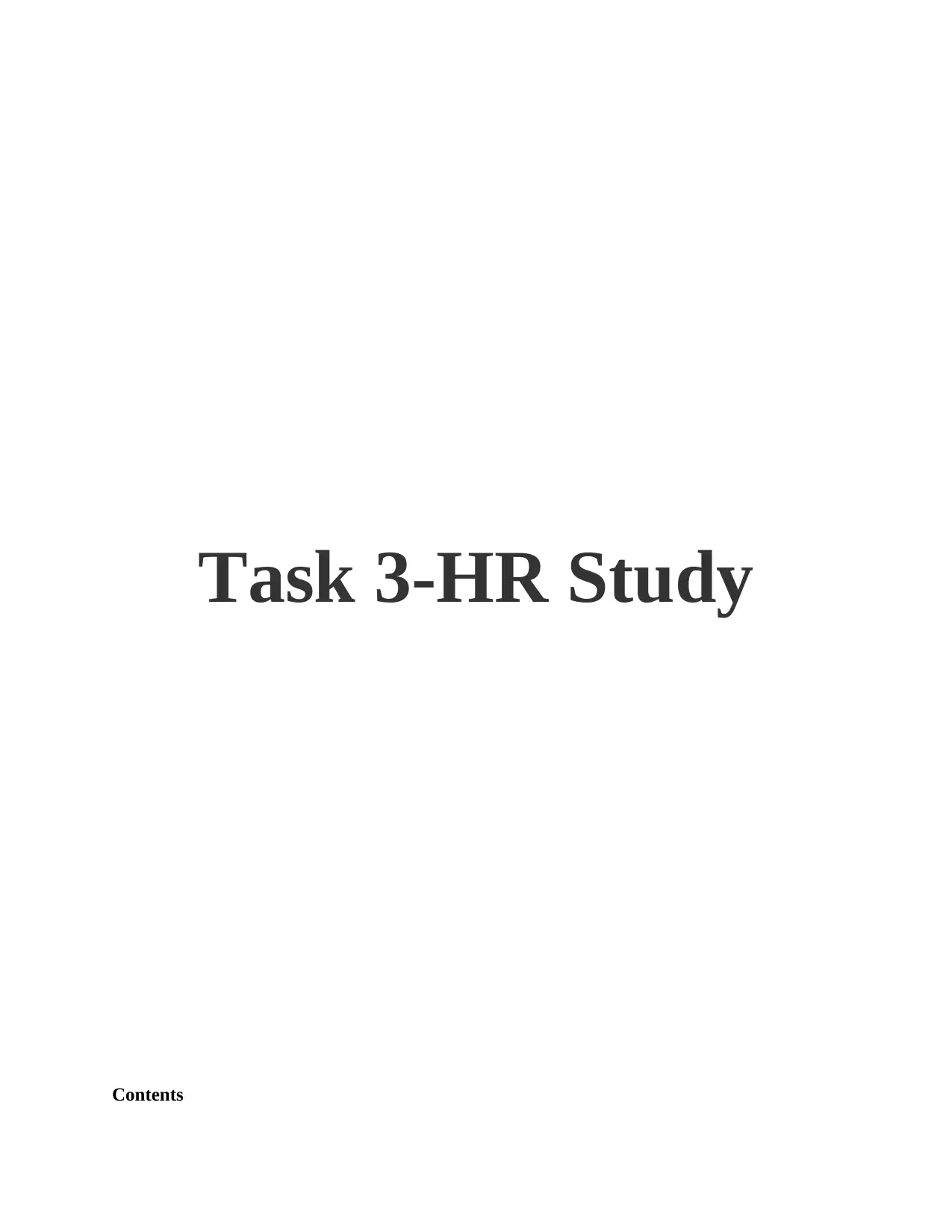
Task 3-HR Study
Contents
Contents
Paraphrase This Document
Need a fresh take? Get an instant paraphrase of this document with our AI Paraphraser
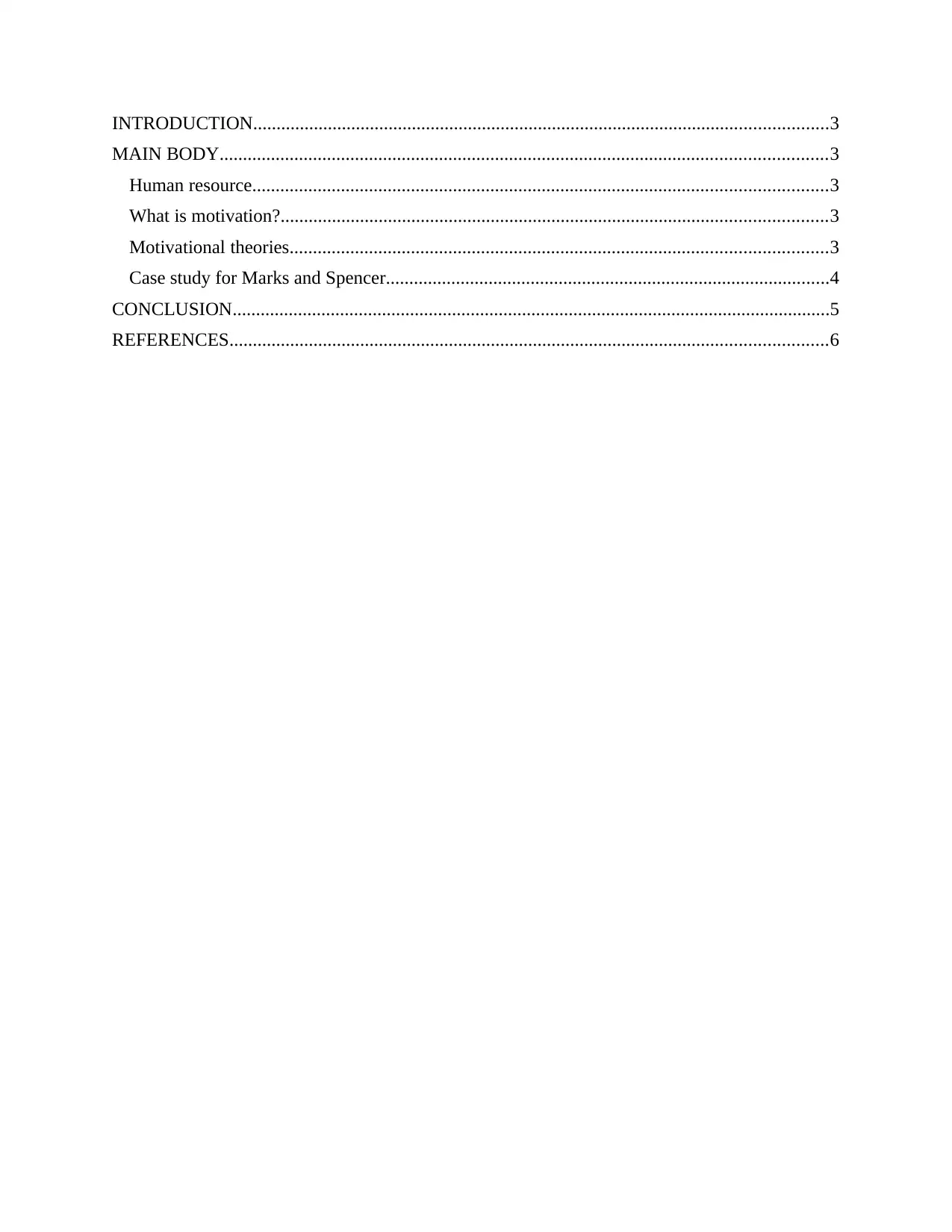
INTRODUCTION...........................................................................................................................3
MAIN BODY..................................................................................................................................3
Human resource...........................................................................................................................3
What is motivation?.....................................................................................................................3
Motivational theories...................................................................................................................3
Case study for Marks and Spencer...............................................................................................4
CONCLUSION................................................................................................................................5
REFERENCES................................................................................................................................6
MAIN BODY..................................................................................................................................3
Human resource...........................................................................................................................3
What is motivation?.....................................................................................................................3
Motivational theories...................................................................................................................3
Case study for Marks and Spencer...............................................................................................4
CONCLUSION................................................................................................................................5
REFERENCES................................................................................................................................6
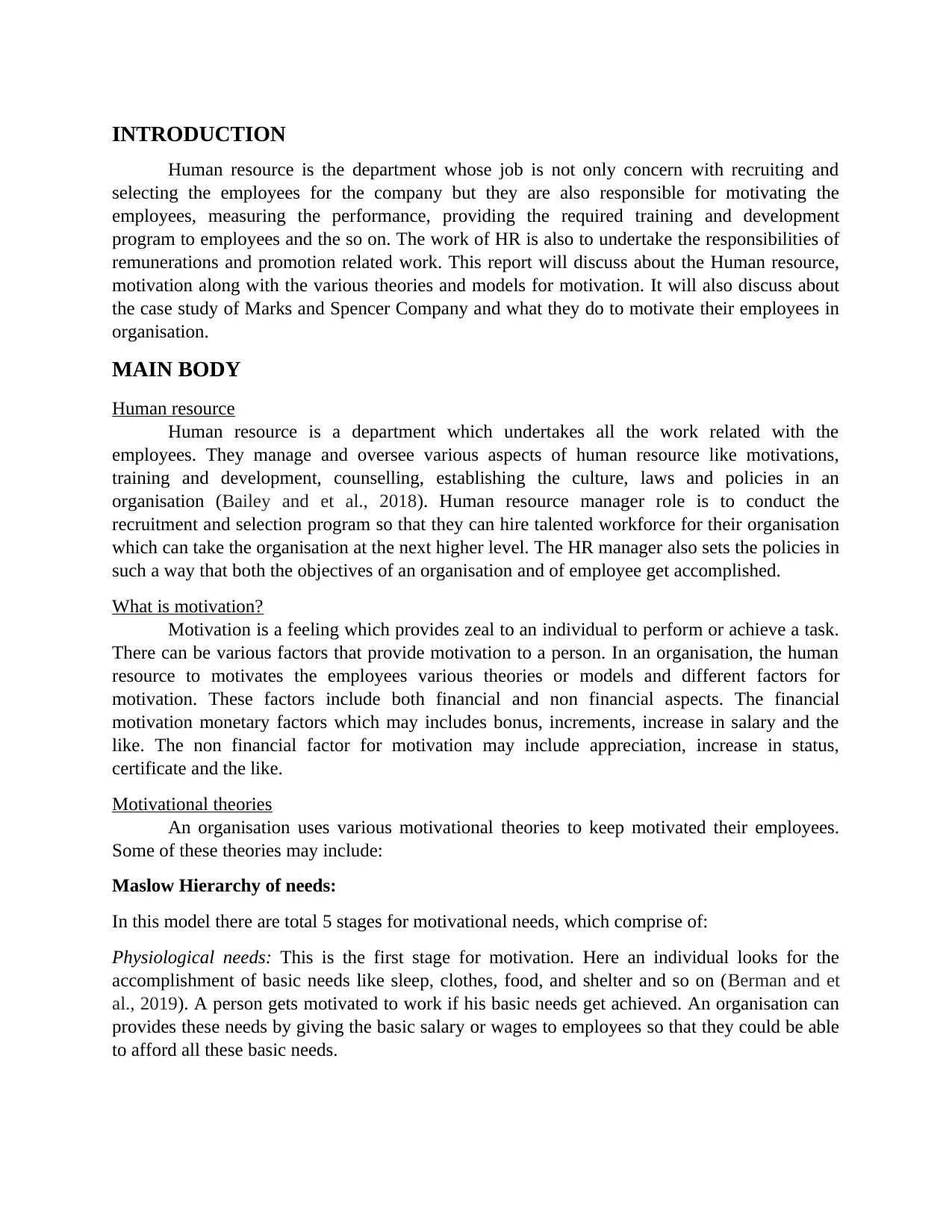
INTRODUCTION
Human resource is the department whose job is not only concern with recruiting and
selecting the employees for the company but they are also responsible for motivating the
employees, measuring the performance, providing the required training and development
program to employees and the so on. The work of HR is also to undertake the responsibilities of
remunerations and promotion related work. This report will discuss about the Human resource,
motivation along with the various theories and models for motivation. It will also discuss about
the case study of Marks and Spencer Company and what they do to motivate their employees in
organisation.
MAIN BODY
Human resource
Human resource is a department which undertakes all the work related with the
employees. They manage and oversee various aspects of human resource like motivations,
training and development, counselling, establishing the culture, laws and policies in an
organisation (Bailey and et al., 2018). Human resource manager role is to conduct the
recruitment and selection program so that they can hire talented workforce for their organisation
which can take the organisation at the next higher level. The HR manager also sets the policies in
such a way that both the objectives of an organisation and of employee get accomplished.
What is motivation?
Motivation is a feeling which provides zeal to an individual to perform or achieve a task.
There can be various factors that provide motivation to a person. In an organisation, the human
resource to motivates the employees various theories or models and different factors for
motivation. These factors include both financial and non financial aspects. The financial
motivation monetary factors which may includes bonus, increments, increase in salary and the
like. The non financial factor for motivation may include appreciation, increase in status,
certificate and the like.
Motivational theories
An organisation uses various motivational theories to keep motivated their employees.
Some of these theories may include:
Maslow Hierarchy of needs:
In this model there are total 5 stages for motivational needs, which comprise of:
Physiological needs: This is the first stage for motivation. Here an individual looks for the
accomplishment of basic needs like sleep, clothes, food, and shelter and so on (Berman and et
al., 2019). A person gets motivated to work if his basic needs get achieved. An organisation can
provides these needs by giving the basic salary or wages to employees so that they could be able
to afford all these basic needs.
Human resource is the department whose job is not only concern with recruiting and
selecting the employees for the company but they are also responsible for motivating the
employees, measuring the performance, providing the required training and development
program to employees and the so on. The work of HR is also to undertake the responsibilities of
remunerations and promotion related work. This report will discuss about the Human resource,
motivation along with the various theories and models for motivation. It will also discuss about
the case study of Marks and Spencer Company and what they do to motivate their employees in
organisation.
MAIN BODY
Human resource
Human resource is a department which undertakes all the work related with the
employees. They manage and oversee various aspects of human resource like motivations,
training and development, counselling, establishing the culture, laws and policies in an
organisation (Bailey and et al., 2018). Human resource manager role is to conduct the
recruitment and selection program so that they can hire talented workforce for their organisation
which can take the organisation at the next higher level. The HR manager also sets the policies in
such a way that both the objectives of an organisation and of employee get accomplished.
What is motivation?
Motivation is a feeling which provides zeal to an individual to perform or achieve a task.
There can be various factors that provide motivation to a person. In an organisation, the human
resource to motivates the employees various theories or models and different factors for
motivation. These factors include both financial and non financial aspects. The financial
motivation monetary factors which may includes bonus, increments, increase in salary and the
like. The non financial factor for motivation may include appreciation, increase in status,
certificate and the like.
Motivational theories
An organisation uses various motivational theories to keep motivated their employees.
Some of these theories may include:
Maslow Hierarchy of needs:
In this model there are total 5 stages for motivational needs, which comprise of:
Physiological needs: This is the first stage for motivation. Here an individual looks for the
accomplishment of basic needs like sleep, clothes, food, and shelter and so on (Berman and et
al., 2019). A person gets motivated to work if his basic needs get achieved. An organisation can
provides these needs by giving the basic salary or wages to employees so that they could be able
to afford all these basic needs.
⊘ This is a preview!⊘
Do you want full access?
Subscribe today to unlock all pages.

Trusted by 1+ million students worldwide
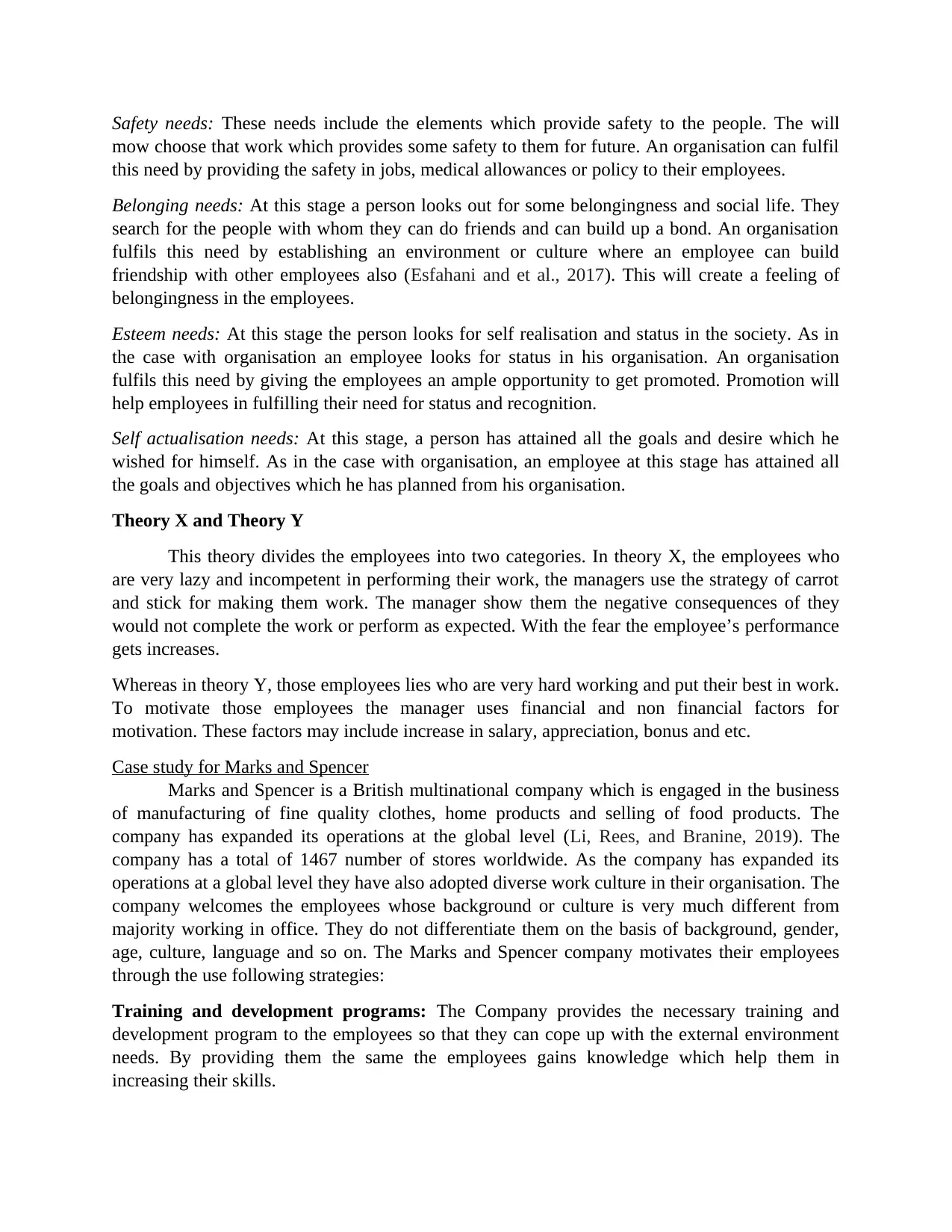
Safety needs: These needs include the elements which provide safety to the people. The will
mow choose that work which provides some safety to them for future. An organisation can fulfil
this need by providing the safety in jobs, medical allowances or policy to their employees.
Belonging needs: At this stage a person looks out for some belongingness and social life. They
search for the people with whom they can do friends and can build up a bond. An organisation
fulfils this need by establishing an environment or culture where an employee can build
friendship with other employees also (Esfahani and et al., 2017). This will create a feeling of
belongingness in the employees.
Esteem needs: At this stage the person looks for self realisation and status in the society. As in
the case with organisation an employee looks for status in his organisation. An organisation
fulfils this need by giving the employees an ample opportunity to get promoted. Promotion will
help employees in fulfilling their need for status and recognition.
Self actualisation needs: At this stage, a person has attained all the goals and desire which he
wished for himself. As in the case with organisation, an employee at this stage has attained all
the goals and objectives which he has planned from his organisation.
Theory X and Theory Y
This theory divides the employees into two categories. In theory X, the employees who
are very lazy and incompetent in performing their work, the managers use the strategy of carrot
and stick for making them work. The manager show them the negative consequences of they
would not complete the work or perform as expected. With the fear the employee’s performance
gets increases.
Whereas in theory Y, those employees lies who are very hard working and put their best in work.
To motivate those employees the manager uses financial and non financial factors for
motivation. These factors may include increase in salary, appreciation, bonus and etc.
Case study for Marks and Spencer
Marks and Spencer is a British multinational company which is engaged in the business
of manufacturing of fine quality clothes, home products and selling of food products. The
company has expanded its operations at the global level (Li, Rees, and Branine, 2019). The
company has a total of 1467 number of stores worldwide. As the company has expanded its
operations at a global level they have also adopted diverse work culture in their organisation. The
company welcomes the employees whose background or culture is very much different from
majority working in office. They do not differentiate them on the basis of background, gender,
age, culture, language and so on. The Marks and Spencer company motivates their employees
through the use following strategies:
Training and development programs: The Company provides the necessary training and
development program to the employees so that they can cope up with the external environment
needs. By providing them the same the employees gains knowledge which help them in
increasing their skills.
mow choose that work which provides some safety to them for future. An organisation can fulfil
this need by providing the safety in jobs, medical allowances or policy to their employees.
Belonging needs: At this stage a person looks out for some belongingness and social life. They
search for the people with whom they can do friends and can build up a bond. An organisation
fulfils this need by establishing an environment or culture where an employee can build
friendship with other employees also (Esfahani and et al., 2017). This will create a feeling of
belongingness in the employees.
Esteem needs: At this stage the person looks for self realisation and status in the society. As in
the case with organisation an employee looks for status in his organisation. An organisation
fulfils this need by giving the employees an ample opportunity to get promoted. Promotion will
help employees in fulfilling their need for status and recognition.
Self actualisation needs: At this stage, a person has attained all the goals and desire which he
wished for himself. As in the case with organisation, an employee at this stage has attained all
the goals and objectives which he has planned from his organisation.
Theory X and Theory Y
This theory divides the employees into two categories. In theory X, the employees who
are very lazy and incompetent in performing their work, the managers use the strategy of carrot
and stick for making them work. The manager show them the negative consequences of they
would not complete the work or perform as expected. With the fear the employee’s performance
gets increases.
Whereas in theory Y, those employees lies who are very hard working and put their best in work.
To motivate those employees the manager uses financial and non financial factors for
motivation. These factors may include increase in salary, appreciation, bonus and etc.
Case study for Marks and Spencer
Marks and Spencer is a British multinational company which is engaged in the business
of manufacturing of fine quality clothes, home products and selling of food products. The
company has expanded its operations at the global level (Li, Rees, and Branine, 2019). The
company has a total of 1467 number of stores worldwide. As the company has expanded its
operations at a global level they have also adopted diverse work culture in their organisation. The
company welcomes the employees whose background or culture is very much different from
majority working in office. They do not differentiate them on the basis of background, gender,
age, culture, language and so on. The Marks and Spencer company motivates their employees
through the use following strategies:
Training and development programs: The Company provides the necessary training and
development program to the employees so that they can cope up with the external environment
needs. By providing them the same the employees gains knowledge which help them in
increasing their skills.
Paraphrase This Document
Need a fresh take? Get an instant paraphrase of this document with our AI Paraphraser
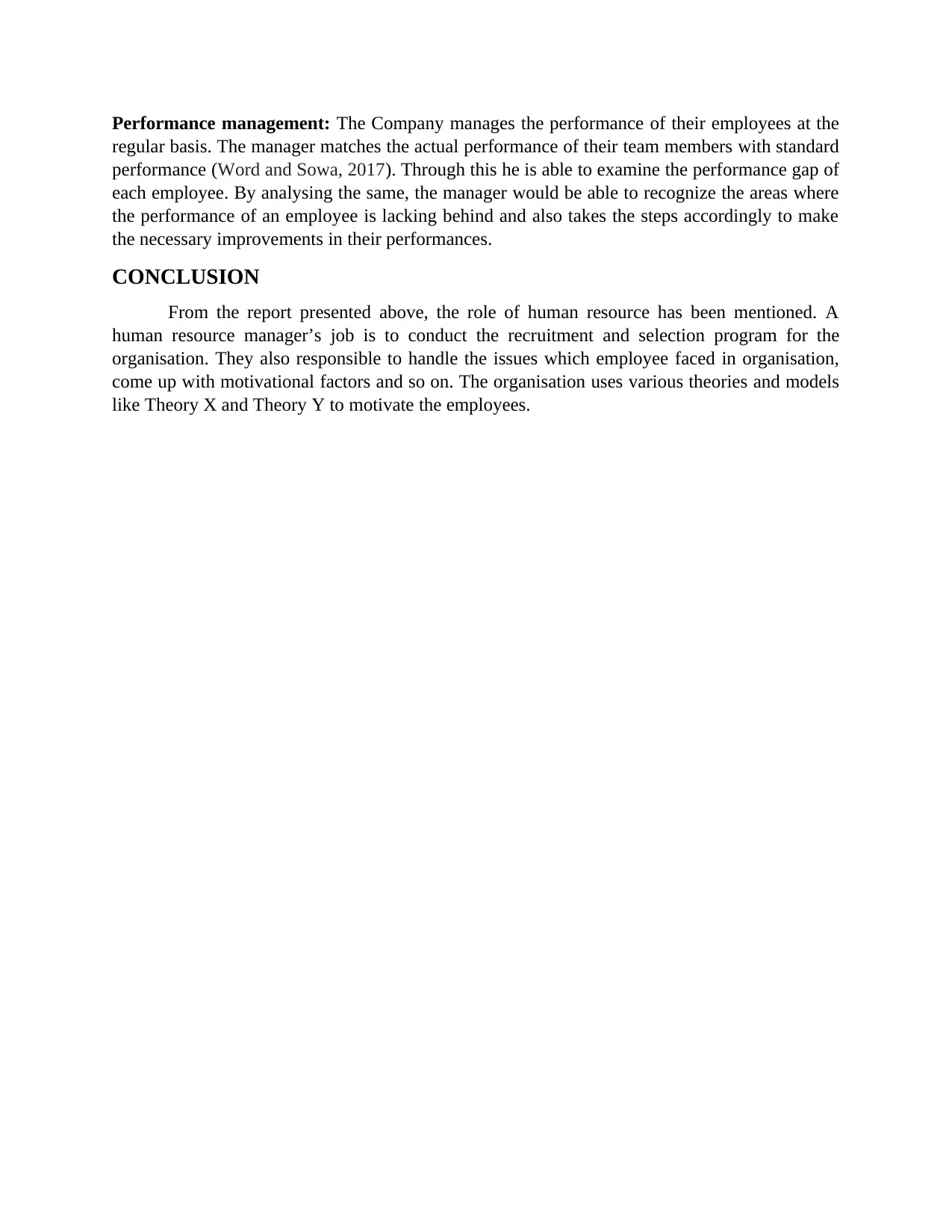
Performance management: The Company manages the performance of their employees at the
regular basis. The manager matches the actual performance of their team members with standard
performance (Word and Sowa, 2017). Through this he is able to examine the performance gap of
each employee. By analysing the same, the manager would be able to recognize the areas where
the performance of an employee is lacking behind and also takes the steps accordingly to make
the necessary improvements in their performances.
CONCLUSION
From the report presented above, the role of human resource has been mentioned. A
human resource manager’s job is to conduct the recruitment and selection program for the
organisation. They also responsible to handle the issues which employee faced in organisation,
come up with motivational factors and so on. The organisation uses various theories and models
like Theory X and Theory Y to motivate the employees.
regular basis. The manager matches the actual performance of their team members with standard
performance (Word and Sowa, 2017). Through this he is able to examine the performance gap of
each employee. By analysing the same, the manager would be able to recognize the areas where
the performance of an employee is lacking behind and also takes the steps accordingly to make
the necessary improvements in their performances.
CONCLUSION
From the report presented above, the role of human resource has been mentioned. A
human resource manager’s job is to conduct the recruitment and selection program for the
organisation. They also responsible to handle the issues which employee faced in organisation,
come up with motivational factors and so on. The organisation uses various theories and models
like Theory X and Theory Y to motivate the employees.
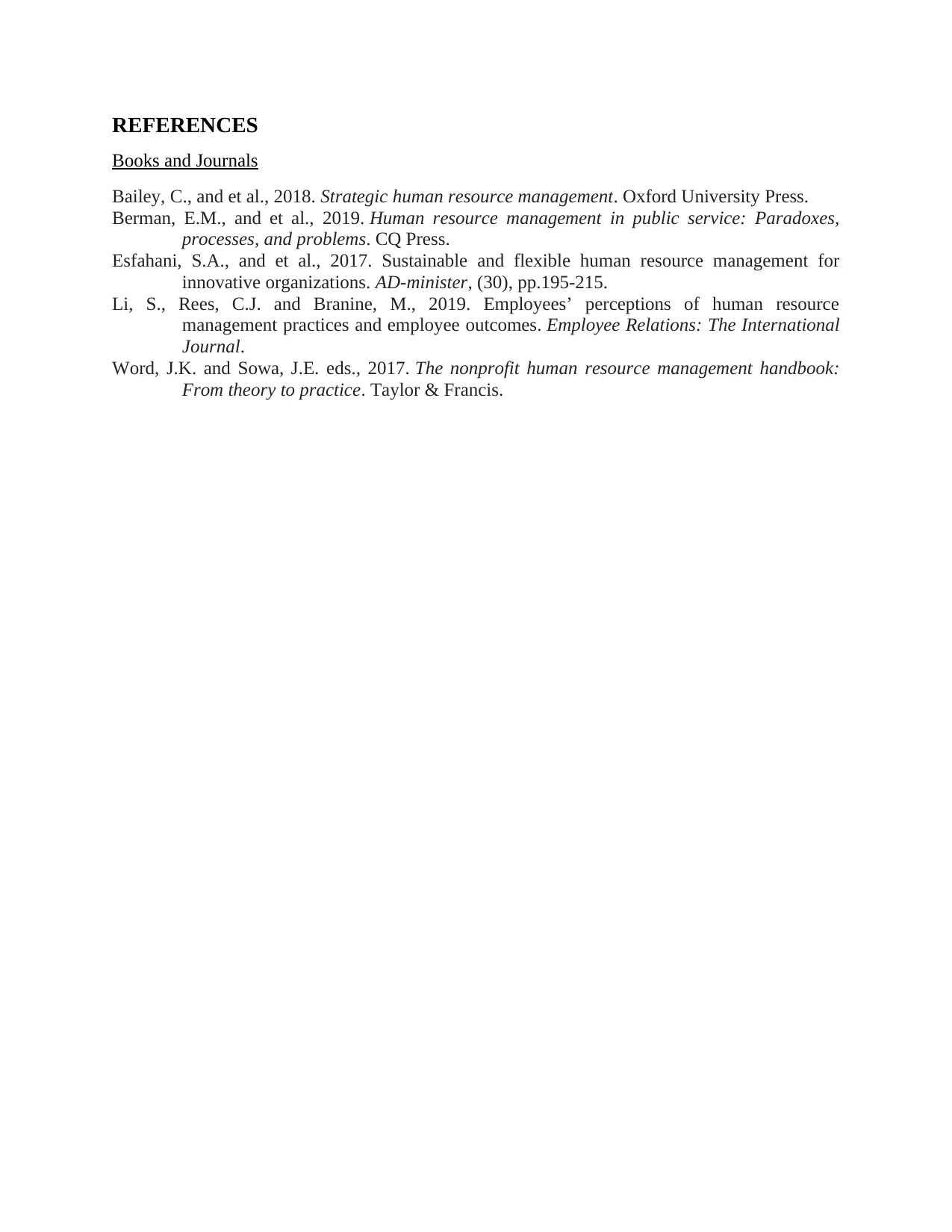
REFERENCES
Books and Journals
Bailey, C., and et al., 2018. Strategic human resource management. Oxford University Press.
Berman, E.M., and et al., 2019. Human resource management in public service: Paradoxes,
processes, and problems. CQ Press.
Esfahani, S.A., and et al., 2017. Sustainable and flexible human resource management for
innovative organizations. AD-minister, (30), pp.195-215.
Li, S., Rees, C.J. and Branine, M., 2019. Employees’ perceptions of human resource
management practices and employee outcomes. Employee Relations: The International
Journal.
Word, J.K. and Sowa, J.E. eds., 2017. The nonprofit human resource management handbook:
From theory to practice. Taylor & Francis.
Books and Journals
Bailey, C., and et al., 2018. Strategic human resource management. Oxford University Press.
Berman, E.M., and et al., 2019. Human resource management in public service: Paradoxes,
processes, and problems. CQ Press.
Esfahani, S.A., and et al., 2017. Sustainable and flexible human resource management for
innovative organizations. AD-minister, (30), pp.195-215.
Li, S., Rees, C.J. and Branine, M., 2019. Employees’ perceptions of human resource
management practices and employee outcomes. Employee Relations: The International
Journal.
Word, J.K. and Sowa, J.E. eds., 2017. The nonprofit human resource management handbook:
From theory to practice. Taylor & Francis.
⊘ This is a preview!⊘
Do you want full access?
Subscribe today to unlock all pages.

Trusted by 1+ million students worldwide
1 out of 6
Related Documents
Your All-in-One AI-Powered Toolkit for Academic Success.
+13062052269
info@desklib.com
Available 24*7 on WhatsApp / Email
![[object Object]](/_next/static/media/star-bottom.7253800d.svg)
Unlock your academic potential
Copyright © 2020–2025 A2Z Services. All Rights Reserved. Developed and managed by ZUCOL.





